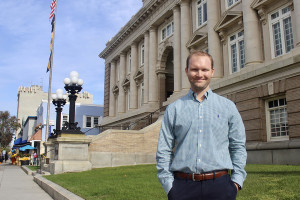Machine Learning Could Give Us Medical Results (Much, Much) Faster — This Research Team Is Working to Make It Possible

Whether closely examining a tissue biopsy for cancerous cells or analyzing the images from an endoscopic camera, many medical tasks rely on visual information to provide much-needed answers. The process, however, can require painstaking and often tedious work from already overburdened healthcare workers. But what if clinicians didn’t need hours to analyze imagery? What if machine learning could take a preliminary look for them?
“Machine learning is basically a way to use computer algorithms to solve specific types of problems, and in particular, the type of problem where we have lots of examples of what to do,” explains Benjamin Mitchell, PhD, an assistant professor of computing science at Villanova University. He likens it to showing algebra students practice problems with provided answers, then assigning them questions to solve themselves. In this case, it’s using examples labeled by clinicians to train computers on medical imagery. The ultimate goal is that these algorithms could then flag health issues from pictures for further human analysis.
For example, many cancer diagnoses rely on studying tissue biopsies under a microscope. “If you treat the field of view of the microscope as an ‘image,’ the pathologist may need to look at the equivalent of thousands of ‘images’ worth of data,” Dr. Mitchell explains. “Even in a patient with cancer, it’s often only a very small part of the slide that contains abnormal tissue.”
Since this requires significant time and training, an automated system could prove clinically useful by identifying definitively normal images and sorting out the ones that need additional attention from a clinician. Even taking a very conservative approach could make a big difference, Dr. Mitchell says. For example, if 1% of the images contain cancerous tissue, and the system asks the human to look at 10% of the images, that’s still 90% that the human doesn’t have to look through.
By developing these types of machine learning systems, his research team hopes to help medical professionals use their time more efficiently. After six years in the healthcare industry, Villanova graduate student Jessica Yarnall is studying how this form of artificial intelligence could apply to chest X-rays. “My research into X-ray images aims to assist physicians in locating issues with a patient so that treatment can be implemented as quickly and accurately as possible,” she explains. “I’m studying machine learning at Villanova because I could see the benefit of this technology in my work in healthcare and how my degree could advance my career.”
Fellow graduate student Jenish Maharjan is applying his study of machine learning to another common diagnostic tool: ultrasound imaging. In this case, an algorithm could potentially guide the user on where to look — and flag any abnormalities. While doctors would still ultimately provide oversight and diagnose problems, the idea is that machine learning could hopefully assist in remote places where resources are stretched thin. “With systems like ultrasound imaging, it’d be great if in the future we could actually make them more available to people and places where doctors and technicians are not easily available,” he says.
As Dr. Mitchell’s team continues its research, they plan to have practitioners inform how the systems would work in practice. “It’s important to build these systems in collaboration with others as much as possible,” Dr. Mitchell states. “It’s not a good idea to replace humans with algorithms in medicine. I want to design a system that works in collaboration with humans — to take advantage of the best properties of the algorithms and also the best properties of humans because they have different strengths.”
Stand at the forefront of machine learning and artificial intelligence by applying to Villanova’s Master of Science in Computer Science program today.
This is a paid partnership between Villanova University College of Liberal Arts and Sciences and Philadelphia Magazine


